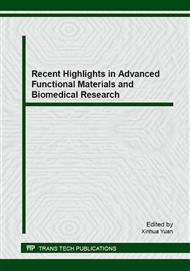[1]
Song SJ, Chen J, Kou X, Chemical constituents from leaves of crataegus pinnatifida Bge, Journal of Shenyang Pharmaceutical University. 23 (2006) 88-90.
Google Scholar
[2]
Ding XB, Jiang DQ, Studies on the chemical constituents of the leaves of crataegus pinnatifida Bge. var. major N. E. Br., China Journal of Chinese Materia Medica. 15 (1990) 39-41.
Google Scholar
[3]
Yang YJ, Wang CL, Wang YL, Experiment research of hawthorn leaves flavonoids on hyperlipidemia rats, Chinese Traditional and Herbal Drugs. 39 (2008) 1848-1850.
Google Scholar
[4]
Liu QL, Yang ZL, Comparison of total flavonoids of different purities from Folium Crataegi in effect of antihyperlipidemia, Strait Pharmaceutical Journal. 20 (2008) 23-24.
Google Scholar
[5]
Liang WW, Yan J, Wu LH, Effect of hawthorn leaf flavonids on lipid metabolism in hyperlipidemia rats, Health Research. 30 (2010) 8-11.
Google Scholar
[6]
Ku S, Kwang, Kwak S, Kwon 0, Hyperoside inhibits high-glucose-induced vascular inflammation in vitro and in vivo, lnflammation. 3 (2014) 10753.
DOI: 10.1007/s10753-014-9863-8
Google Scholar
[7]
Yang YJ, Dong XQ, Guo JK, Experimental research of blood-quickening Stasis-transforming actions of hawthorn leaf flavonoids, Hebei Medicine. 15 (2009) 22-23.
Google Scholar
[8]
Min Q, Bai YT, Shu SJ, The protectional effect of Hawthorn leaves flavonoids on myocardial ischemia reperfusion in rats, Pharmacology and Clinics of Chinese Materia. 19 (2008) 19-21.
Google Scholar
[9]
Yu B, Li HT, Zhang L, Protective effect of total flavonoids from hawthorn leaf on ligation-induced acute myocardial ischemia in anesthetized dogs, Traditional Chinese Drug Research & Clinical Pharmacology. 19(2008) 461-463.
Google Scholar
[10]
Liu JH, Zheng YQ, Li Y, Hawthorn leaves flavonoids decreases inflammation related to acute myocardial ischemia/reperfusion in anesthetized dogs, Chinese Journal of lntegrative Medicine. 19 (2013) 582-588.
DOI: 10.1007/s11655-012-1250-4
Google Scholar
[11]
Jayachandran KS, Khan M, Selvendiran K, Crataegus oxycantha extract attenuates apoptotic incidence in myocardial ischemia-reperfusion injury by regulating Akt and HIF-1 signaling pathways, J Cardiovase Pharmaco1. 56 (2010) 526-531.
DOI: 10.1097/fjc.0b013e3181f64c51
Google Scholar
[12]
Li FZ, Fan LL, The extracts impacts on dog's left ventricle of the leaf of the hawthorn, Journal of Animal Science and Veterinary Medicine. 26 (2007) 21-23.
Google Scholar
[13]
Shao X, Dong Liu Y, LI XL, Effects of vitexin on hemodynamics and myocardial oxygen consumption in anesthetized dogs, Anhui Medical and Pharmaceutical Journal. 14 (2010) 1001-1004.
Google Scholar
[14]
Kuang JP, Hu WJ, Wu GX, Diuretic effects of hawthorn leaves, China Journal of Chinese Materia Medica. 17 (1992) 52.
Google Scholar
[15]
Zhao JG, Yu B, Experimental study of hawthorn leaves flavonoids on the impact of rats sports ability, Shandong Sports Science & Technology, 23 (2001) 25-26.
Google Scholar
[16]
Tankanow R, Tamer HR, Streetman DS, lnteraction study between digoxin and a preparation of hawthorn (Crataegus oxyacantha), Clin Pharmaco1. 43(2003) 637-642.
DOI: 10.1177/0091270003043006009
Google Scholar
[17]
Tauchert M. Efficacy and safety of crataegus extract WS 1442 in comparison with placebo in patients with chronic stable New York Heart Association class – III heart failure, Am Heart J. 143(2002) 910-915.
DOI: 10.1067/mhj.2002.121463
Google Scholar
[18]
Zick SM, Vautaw BM,Gi11espie B, Hawthorn extract randomized blinded chronic heart failure (HERB CHF) trial, Eur J Heart Fai1, 11(2009) 990-999.
DOI: 10.1093/eurjhf/hfp116
Google Scholar
[19]
Egon K, Fathi AM, Standardized extracts from hawthorn leaves and flowers in the treatment of cardiovascular disorders-preclinical and clinical studies, Planta Med. 77 (2011) 1123-1128.
DOI: 10.1055/s-0030-1270849
Google Scholar


